When we think of prehistoric reptiles, dinosaurs typically dominate our imagination. However, long before the first dinosaurs appeared, their ancestors—the early archosaurs—were evolving crucial adaptations that would eventually lead to dinosaurian dominance. These fascinating creatures from the Triassic period established the groundwork for one of the most successful animal lineages in Earth’s history. Despite their evolutionary importance, these early archosaurs remain relatively unknown to the general public. This article explores these remarkable animals, their significance in evolutionary history, and how they set the stage for the rise of dinosaurs.
What Exactly Are Archosaurs?

Archosaurs, meaning “ruling reptiles,” constitute a major group of diapsid reptiles that first appeared during the late Permian period, roughly 250 million years ago. This clade includes some of the most diverse and successful vertebrate groups ever to exist on Earth: dinosaurs (including modern birds), pterosaurs, crocodilians, and their extinct relatives. The defining characteristics of archosaurs include a distinctive opening in front of the eyes called the antorbital fenestra, teeth set in sockets rather than fused to the jaw, and often an upright stance. Modern representatives of this ancient lineage include only birds and crocodilians, but during the Triassic period, archosaurs existed in a bewildering variety of forms and ecological niches, demonstrating remarkable evolutionary experimentation following the devastating Permian-Triassic extinction event.
The Rise After Earth’s Greatest Catastrophe
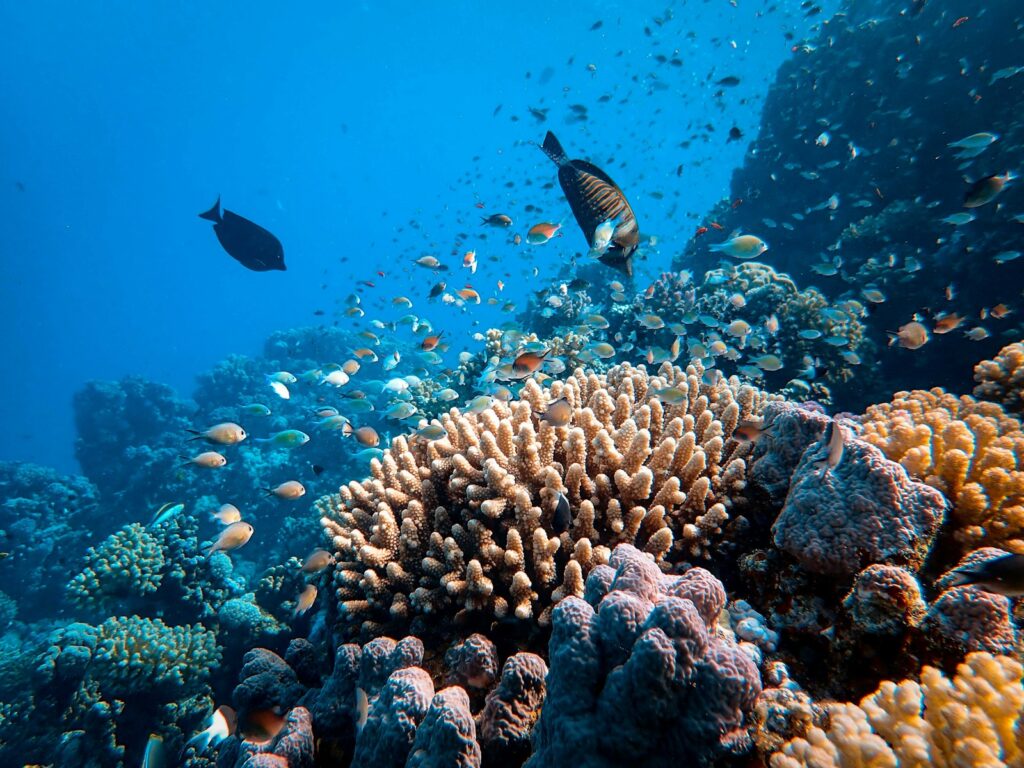
The emergence of early archosaurs is intrinsically linked to one of the most catastrophic events in Earth’s history: the Permian-Triassic extinction event, which occurred approximately 252 million years ago. This “Great Dying” eliminated an estimated 90% of marine species and 70% of terrestrial vertebrate species, creating ecological vacancies across the planet. In the aftermath of this mass extinction, archosaurs found opportunities to diversify and expand into ecological niches previously occupied by other groups. Their adaptable body plans and efficient respiratory systems may have provided critical advantages during the harsh environmental conditions of the early Triassic. This period of recovery and radiation set the stage for archosaur dominance, particularly as the Triassic climate stabilized and new ecosystems developed, allowing these resilient reptiles to become the predominant large land vertebrates for millions of years to come.
Euparkeria: The Textbook Transitional Archosaur
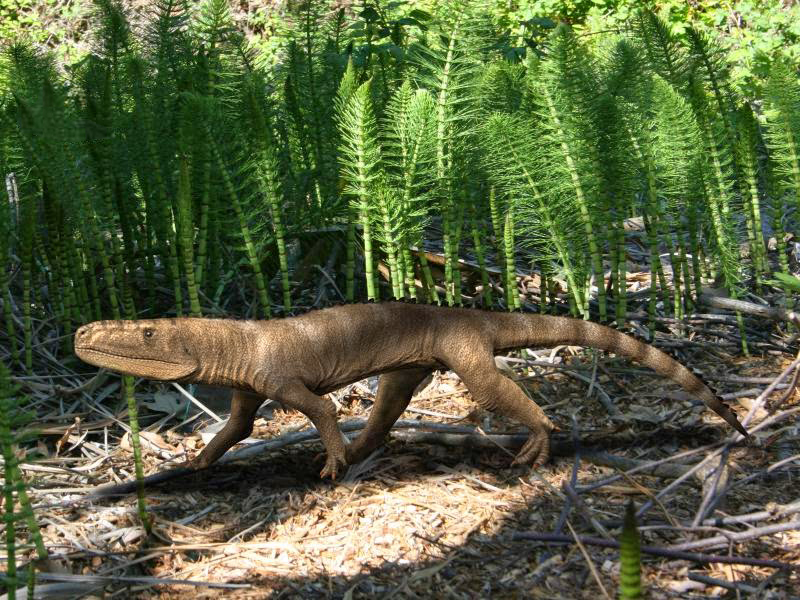
Euparkeria capensis stands as one of the most significant early archosaurs in evolutionary studies, often cited as a classic transitional fossil illustrating the evolution toward dinosaurs and other later archosaurs. Living approximately 245-230 million years ago in what is now South Africa, this small reptile measured only about 3 feet (1 meter) in length. Its significance lies in its combination of primitive and derived characteristics—while retaining many features of earlier reptiles, Euparkeria showed advancements in limb positioning that suggest it could adopt both a sprawling and a more upright stance. This flexibility in posture represents a critical evolutionary step toward the fully upright gait that would later characterize dinosaurs. Though not a direct ancestor to dinosaurs, Euparkeria provides valuable insights into the evolutionary trajectory that ultimately produced them, functioning as a sort of “great uncle” in the archosaur family tree rather than a direct progenitor.
The Bizarre Sailbacks: Ctenosauriscids
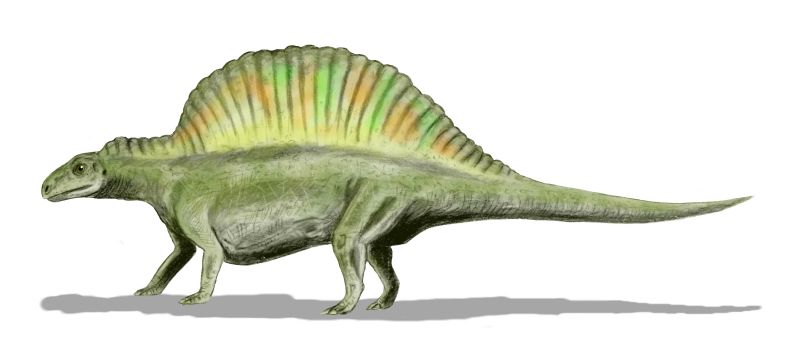
Among the most visually striking early archosaurs were the ctenosauriscids, a family characterized by their remarkable sail-like structures formed by elongated neural spines along their backs. These neural spines could reach impressive heights, creating a sail reminiscent of the much later and unrelated Dimetrodon or Spinosaurus. Arizonasaurus, discovered in the southwestern United States, represents one of the better-known members of this group, sporting a sail that may have served multiple functions, including thermoregulation, display, or energy storage. Living approximately 242 million years ago, these peculiar archosaurs typically reached lengths of 3-4 meters and featured crocodile-like skulls paired with more upright hindlimb postures. The ctenosauriscids demonstrate the remarkable experimentation in body plans that characterized early archosaur evolution, showing how quickly these animals diversified into specialized forms following the Permian-Triassic extinction.
Erythrosuchids: The Early Apex Predators

The erythrosuchids represented some of the most formidable predators of the early to middle Triassic ecosystems, evolving shortly after the Permian-Triassic extinction event. These massive carnivores, sometimes called “red crocodiles” (though not closely related to modern crocodilians), could reach lengths of up to 5 meters (16 feet) and featured enormous skulls relative to their body size—sometimes constituting nearly a quarter of their total length. Erythrosuchus from South Africa, the namesake of the group, possessed powerful jaws lined with sharp, serrated teeth perfect for dispatching large prey. Unlike later archosaurs, erythrosuchids maintained a more sprawling posture, but their large size and predatory adaptations allowed them to dominate terrestrial ecosystems for millions of years. Their reign as apex predators eventually ended as more derived archosaurs with improved locomotion evolved, but during their time, these animals represented some of the most fearsome carnivores on the planet.
Posture Revolution: The Shift to Upright Stance
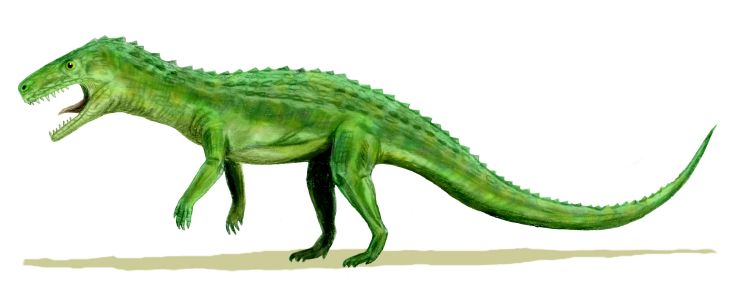
One of the most significant evolutionary developments among early archosaurs was the gradual transition from a sprawling posture, typical of most reptiles, to a more upright stance. This postural revolution began with subtle changes to the hip and limb structure that allowed for a semi-erect gait in some early archosaurs. The acetabulum (hip socket) began to develop a medial wall reduction or perforation, allowing the femur (thigh bone) to be tucked more directly under the body rather than extending sideways. This anatomical innovation dramatically improved locomotor efficiency, enabling faster movement and better endurance. By the middle Triassic, some archosaur lineages had developed a fully upright or parasagittal stance, with limbs positioned directly beneath the body—a key adaptation that would later be inherited by dinosaurs and contribute to their success. This postural evolution represents one of the most important transitions in vertebrate locomotion, setting archosaurs apart from other reptiles and contributing to their evolutionary success.
Rauisuchians: The Dominant Predators of Middle Triassic
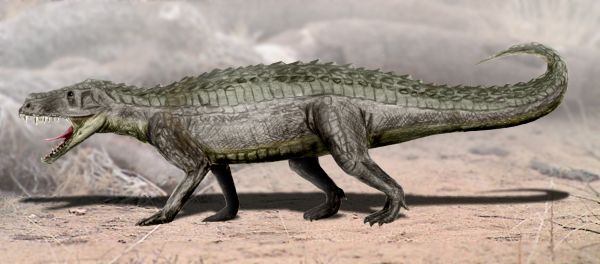
The rauisuchians emerged as a diverse group of large, carnivorous archosaurs that dominated terrestrial ecosystems throughout much of the Middle and Late Triassic periods. These impressive predators, some reaching lengths of over 6 meters (20 feet), combined an increasingly upright stance with powerful skulls equipped with serrated, blade-like teeth. Prestosuchus from Brazil and Postosuchus from North America exemplify the group, demonstrating adaptations for active predation including strong limbs and robust skulls capable of delivering devastating bites. Unlike earlier archosaurs, many rauisuchians possessed a more erect hindlimb posture, allowing for more efficient locomotion when pursuing prey. Their body proportions, with relatively long hind limbs and shortened forelimbs, hinted at the body plan that would later characterize theropod dinosaurs. Though superficially resembling dinosaurs in some aspects, rauisuchians represent a separate branch of archosaur evolution that was eventually supplanted by true dinosaurs toward the end of the Triassic period.
Aetosaurs: The Armored Herbivores
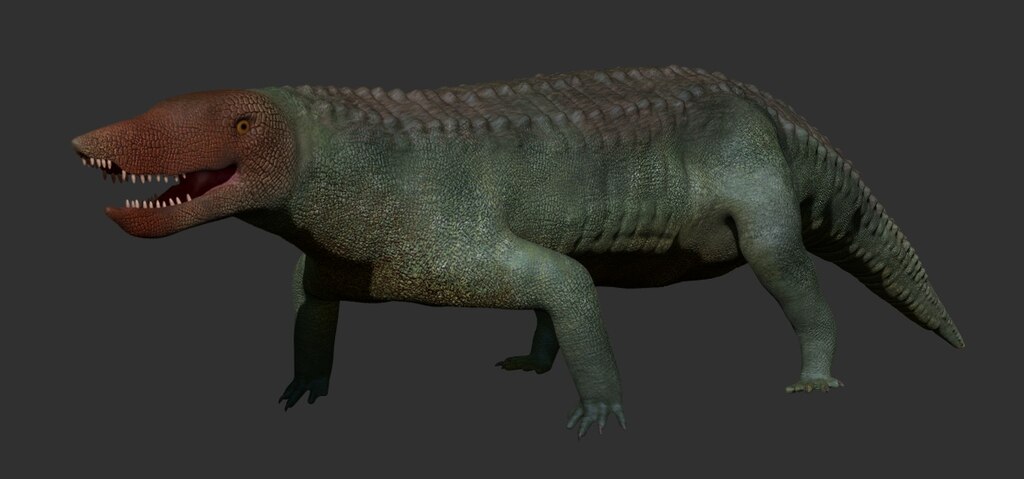
Not all early archosaurs were fearsome predators; the aetosaurs evolved as a specialized group of herbivorous archosaurs covered in elaborate armor plating. These medium to large-sized animals, reaching lengths of 3-5 meters (10-16 feet), were characterized by their heavily armored bodies featuring rows of bony scutes forming a protective carapace similar to modern crocodilians but much more extensive. Aetosaurs possessed distinctive pig-like snouts and small, leaf-shaped teeth adapted for processing plant material—a significant dietary departure from the carnivorous habits of most other early archosaurs. Species like Desmatosuchus, notable for its impressive shoulder spikes, demonstrate the diversity within this group. Aetosaur armor typically featured intricate patterns and textures that vary between species, making their scutes valuable for taxonomic identification even from fragmentary remains. These successful herbivores represent one of the first major radiations of plant-eating archosaurs, filling ecological niches that would later be occupied by ankylosaurs and other armored dinosaurs.
Phytosaurs: Crocodile Mimics of the Triassic
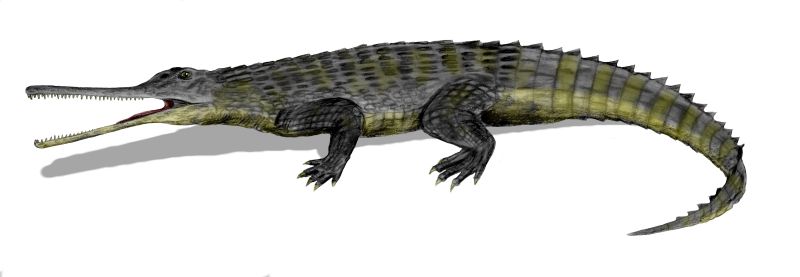
Phytosaurs represent one of the most remarkable examples of convergent evolution in the fossil record, bearing an uncanny resemblance to modern crocodilians despite being separated by over 200 million years of independent evolution. These semi-aquatic predators evolved elongated snouts filled with conical teeth, dorsally positioned eyes and nostrils, and limbs adapted for both swimming and terrestrial locomotion. Unlike crocodilians, however, phytosaurs’ nostrils were positioned far back on their snouts, near their eyes, rather than at the tip. Ranging from 3 to 12 meters (10 to 40 feet) in length, phytosaurs dominated freshwater ecosystems throughout the Late Triassic, filling the ecological niche that would later be occupied by true crocodilians. Species like Rutiodon and Machaeroprosopus thrived in rivers and wetlands across Pangaea, ambushing prey at water margins just as modern crocodiles do. Despite their successful adaptation to aquatic environments, phytosaurs disappeared at the end of the Triassic period during a mass extinction event, leaving their ecological niche temporarily vacant until crocodilomorphs evolved similar adaptations.
Ornithosuchids: The Unusual Bipedal Experimenters

The ornithosuchids represent one of the more enigmatic groups of early archosaurs, combining features that made them unique among their contemporaries. These medium-sized predators from the Late Triassic, such as Ornithosuchus from Scotland and Riojasuchus from Argentina, possessed powerful hindlimbs that suggest they may have been capable of facultative bipedalism—moving on two legs when running but adopting a quadrupedal stance when moving slowly. Their skulls were deep and powerfully built, equipped with heterodont dentition (different tooth types) including enlarged canine-like teeth. Perhaps most strikingly, ornithosuchids featured a unique “reverse crocodile” ankle joint configuration that differs from both the typical archosaur condition and that of dinosaurs. Standing approximately 2-3 meters (6-10 feet) in length, these animals occupied a predatory niche in Late Triassic ecosystems alongside early dinosaurs. The ornithosuchids demonstrate yet another experimental body plan within the archosaur radiation, emphasizing the remarkable diversity of locomotor and predatory adaptations that evolved within this group.
Proterochampsids: The Riverside Hunters
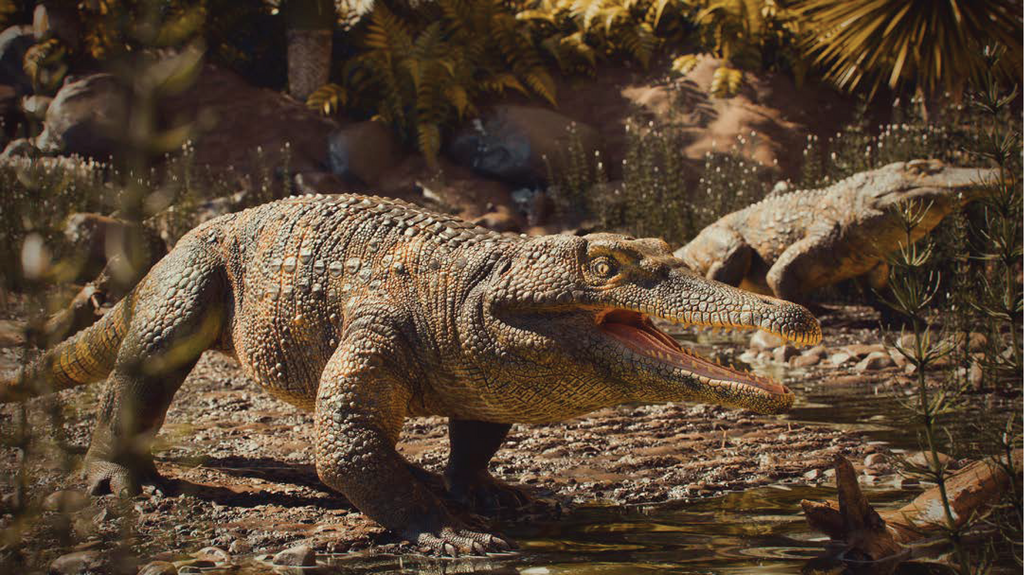
Proterochampsids constituted a specialized group of semi-aquatic archosaurs that evolved to exploit the rich resources of Triassic riverside environments. These distinctive reptiles, including genera like Proterochampsa and Chanaresuchus, developed elongated, flattened crocodile-like skulls with upward-facing eyes that would have allowed them to lurk mostly submerged while spotting prey above the water surface. Despite these crocodile-like adaptations, proterochampsids maintained a more sprawling posture than many of their archosaur contemporaries, with limbs extending outward from the body rather than positioned underneath. Typically reaching lengths of 1-2 meters (3-7 feet), these animals likely hunted fish and other aquatic organisms while also potentially ambushing terrestrial animals that came to the water’s edge. The proterochampsids represent an early example of adaptation to a semi-aquatic niche within Archosauria, evolving crocodile-like features millions of years before true crocodilians appeared. Their specialized lifestyle exemplifies how early archosaurs rapidly diversified to fill various ecological niches following the Permian-Triassic extinction.
The Road to Dinosauria: Lagerpetids and Silesaurids
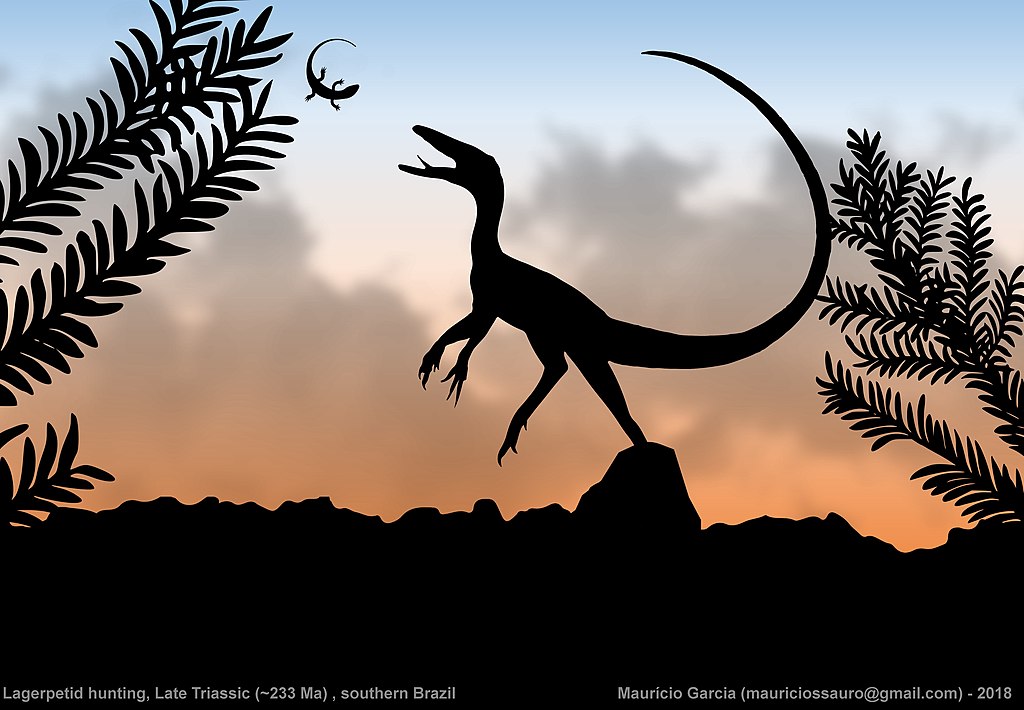
As the Triassic progressed, certain archosaur lineages began developing features that would eventually characterize true dinosaurs. The lagerpetids and silesaurids represent two of the most significant groups of dinosauromorphs—the broader group that includes dinosaurs and their closest relatives. Lagerpetids like Lagerpeton were small, lightly built animals with distinctly elongated ankle bones and adaptations for agile, possibly bipedal locomotion. Silesaurids, exemplified by Silesaurus from Poland, grew larger (up to 2-3 meters long) and developed features strikingly similar to early ornithischian dinosaurs, including leaf-shaped teeth suggesting an herbivorous diet. Both groups possessed the characteristic elongated lower legs, compact feet, and increasingly upright posture that would become hallmarks of dinosaur locomotion. These animals lived alongside early true dinosaurs during the Middle to Late Triassic, with fossil evidence suggesting a gradual rather than sudden transition to dinosaur dominance. The evolutionary innovations seen in lagerpetids and silesaurids—including improved locomotion, specialized diets, and more efficient respiration—paved the way for the eventual rise of dinosaurs as the dominant large land vertebrates for the next 165 million years.
Extinction and Legacy: How Early Archosaurs Shape Our World Today

While many groups of early archosaurs disappeared during the end-Triassic extinction event approximately 201 million years ago, their evolutionary legacy persists in profound ways. This extinction, potentially triggered by massive volcanic eruptions associated with the breakup of Pangaea, eliminated numerous archosaur lineages including phytosaurs, aetosaurs, and most rauisuchians. However, certain archosaur groups—most notably dinosaurs, pterosaurs, and crocodylomorphs—survived and flourished in the aftermath. The adaptations pioneered by early archosaurs, such as upright posture, efficient respiration, and specialized diets, formed the foundation for the subsequent success of these surviving lineages. Today, the approximately 10,000 species of living birds represent direct descendants of dinosaur archosaurs, while crocodilians carry on the legacy of another ancient archosaur lineage. Modern research on archosaur evolution has important implications for understanding major evolutionary transitions, convergent evolution, and how animals respond to mass extinctions. The early archosaurs thus represent not just an interesting chapter in prehistoric life, but a crucial evolutionary experiment whose innovations continue to shape Earth’s fauna 250 million years after they first appeared.
Conclusion

The early archosaurs deserve far more recognition than they typically receive in popular discussions of prehistoric life. These remarkable animals pioneered adaptations that would reshape terrestrial ecosystems for hundreds of millions of years to follow. From the crocodile-like phytosaurs to the almost dinosaurian silesaurids, these creatures demonstrate the incredible diversity that evolved in the wake of Earth’s most devastating extinction. As we continue to discover and study early archosaur fossils, we gain valuable insights into evolutionary processes, ancient ecosystems, and the origins of the dinosaur lineage that would eventually give rise to modern birds. The next time you observe a bird or crocodilian, remember that you’re witnessing the living legacy of an extraordinary group of animals whose evolutionary innovations began in the aftermath of catastrophe, eventually leading to some of the most successful vertebrates in Earth’s history.



